► New Ford Explorer and Renault Scenic battle Tesla
► The Model Y arrived from the future…
► But the old timers are fighting back hard
Tesla’s Model Y arrived like a family-friendly gift from a sci-fi utopia. But the old-timers at Renault and Ford aren’t content to let Elon Musk have it all his own way. Which family-sized EV comes out on top in our triple test?
Pre-flight briefing: Ford Explorer
What’s the line-up?
The Explorer range starts from £39,875. Three powertrain options are available: 52kWh rear-wheel drive, 77kWh rear-wheel drive, and 79kWh all-wheel drive. AWD is fastest; 77kWh RWD best for range. Entry-level trim is Select, but we’re testing Premium: the most expensive car here, but finance is very attractive.
Read our Ford Explorer review
Data
Price £49,975 (RWD Extended Range Premium)
Powertrain 77kWh battery, e-motor, rear-wheel drive
Performance 282bhp, 402Ib ft, 6.4sec 0-62mph, 112mph
Weight 2102kg
Efficiency 4.2 miles per kWh (claimed), 3.6 (tested), 354-mile range (claimed), 325 miles (tested)
Length/width/height 4468/2063/1630mm
Boot capacity 465 litres
Pre-flight briefing: Tesla Model Y
What’s the line-up?
The Model Y range starts from £46,990. On top of the Long Range Rear-Wheel Drive tested here, you can also get a Long Range All-Wheel Drive and a Performance. Our test car gets a 93kWh battery and 342bhp electric motor. It’s the most expensive car here on PCP on the same terms as the other two, and it’s also worth pointing out that this test was conducted before the reveal of the Model Y facelift.
Read our Tesla Model Y review
Data
Price £46,990
Powertrain 93kWh battery, e-motor, rear-wheel drive
Performance 342bhp, 310Ib ft, 5.7sec 0-62mph, 100mph
Weight 1959kg
Efficiency 4.0 miles per kWh (official), 4.1 miles per kWh (tested), 373-mile range (claimed), 381 miles (tested)
Length/width/height 4751/1921/1624mm
Boot capacity 854 litres (measured from floor to ceiling, not parcel shelf)
Pre-flight briefing: Renault Scenic
What’s the line-up?
The Scenic range starts from £37,495. There are two battery sizes and power outputs, and three trim levels. Entry-level Techno is the only Scenic available with the 60kWh battery pack and 168bhp motor. The 217bhp motor and 87kWh battery are standard on Esprit Alpine and Iconic. It’s the most affordable of our trio.
Read our Renault Scenic review
Data
Price £45,495 (Iconic)
Powertrain 87kWh battery, e-motor, front-wheel drive
Performance 217bhp, 221Ib ft, 7.9sec 0-62mph, 105mph
Weight 1860kg
Efficiency 4.4 miles per kWh (official), 3.3 miles per kWh (tested), 379-mile range (claimed), 287 miles (tested)
Length/width/height 4470/2085/1571mm
Boot capacity 545 litres
Ford Explorer vs Tesla Model Y vs Renault Scenic: the test
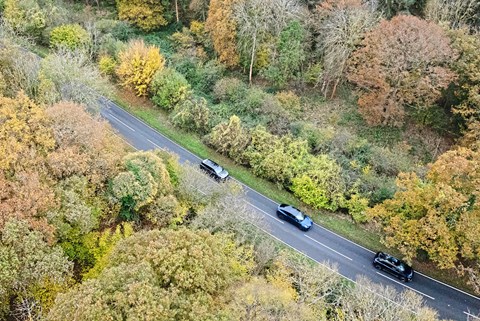
This has not started well. I’ve barely left the car park in the Tesla Model Y and already it’s annoyed me. The steering feels artificial, overly fast and heavy. The low-speed ride is unresolved, failing to cope with even modest speed bumps. I’ve driven Model Ys before, but this is my first time in the new Long Range Rear-Wheel Drive, and it just doesn’t feel good.
But as we’ve found before, you do find yourself adapting and getting used to its sub-optimal chassis set-up. And of course there are plenty of other reasons to like the Model Y, as its several million buyers have found in the four years since it arrived. It’s keenly priced, practical, efficient, fast, and has the best public charging network currently available.
The range has never been bad, but even so, Tesla’s never-ending quest for improvement has led it to introduce this Long Range Rear-Wheel Drive version as both the entry point to the range and its most distance-friendly option.
The huge-selling Tesla has fresh competition all the time, and this duo look set to give it a good contest. The new electric-only Ford Explorer is a far cry from the last Explorer sold in the UK, a 4.0-litre V6-powered SUV that went off sale back in 2001. This new bearer of the badge, based on the VW ID. 4, is more than a foot shorter than the last Explorer, but manages to weigh 20kg more, because that’s what happens when you swap a combustion powertrain for electric.
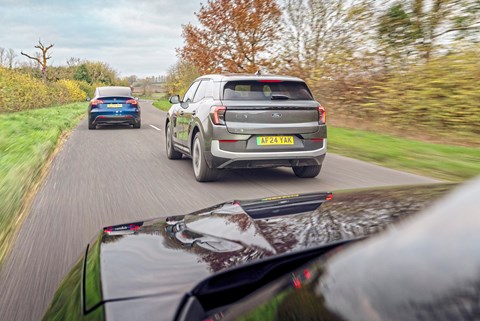
It’s loosely SUV-shaped, and all-wheel drive is available, but in order to make it as directly comparable as possible with the Tesla we’ve selected a rear-wheel-drive Extended Range version.
They’re up against the Renault Scenic E-Tech, an SUV that’s already won a CAR group test against the talented Skoda Enyaq and underwhelming Peugeot E-3008. Once again, we’ve gone for the longest-range version and, like the Ford, it’s in the top trim level. Even so, it’s the cheapest SUV here whether you’re buying outright or financing. Renault really is on a roll when it comes to EVs.
Like the Explorer, the Scenic resurrects a name from its manufacturer’s back catalogue; in this case, the popular and long-running MPV. Neither naming choice has caused much of a stir, certainly compared to the brouhaha triggered by Ford’s use of the Capri name for another VW-based EV, essentially a slightly lower Explorer. Either way, we’re testing the cars, not their makers’ naming strategies, any more than we’re assessing the Model Y based on the Tesla boss’s dubious political utterances.
After a couple of days with the Y, I’ve got used to it, more or less. It’s still not as good as you’d hope around town, but at higher speeds the steering feels more appropriate, and the ride smooths out significantly, too. It’s still on the firm side, but on the open road the jarring fidgetiness that plagues it around town becomes nothing more troublesome than tight damping, while the stiff springs keep the body pleasingly upright. Chuck it into a corner and it hangs on gamely, the stability control working overtime to successfully prevent tyres slipping under acceleration or hard cornering forces.
Helped by acceleration that’s far beyond what’s necessary in a family SUV, you can cross country at a fair old lick, albeit with little in the way of fun or involvement. It’s only fair to say that some colleagues found the steering’s speed fine, although even after several days I still reckoned it was too fast and nervous just off-centre, and lacking in a sense of connection to the front tyres.
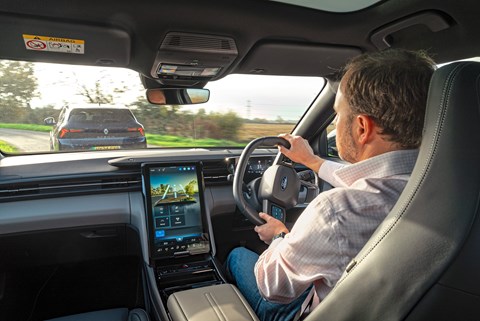
Time to swap into the Ford. I’m assuming that the Explorer will steer and ride better than the Model Y, based on fond memories of various past and current cars wearing the blue oval. The Mk1 Ford Focus, dearly departed Fiesta ST and even the surprisingly entertaining current Ford Kuga all suggest the Explorer should rise above the soggy ID. 4 and indeed the softly sprung Enyaq, which also shares much with the VW.
It’s certainly firmer than the ID. 4. However, unlike the unrelentingly stiff Tesla, there’s a consistency to the ride and a quality to the damping. Furthermore, the Ford steers with precision and predictability and gives its driver a better indication of what the front tyres are doing. There’s perhaps a little more lean and maybe not quite as much grip, but the Explorer is the more entertaining and engaging SUV to drive. Flick the stability control into its Sport setting and you can even steer the car on the throttle a little, although anything that results in opposite lock soon gets shut down.
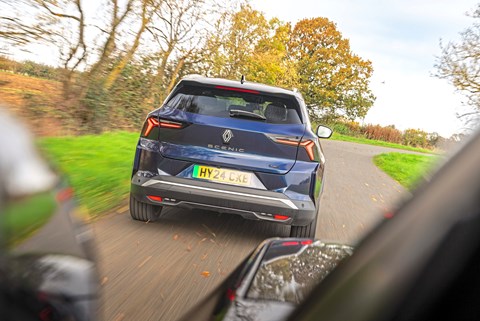
You do ultimately feel the Explorer’s weight when you’re getting a wriggle on, but it’s not enough to stop you having fun. The brakes let the side down, though. The Model Y has the most natural-feeling stoppers on test compared to the Ford’s clearer separation between regenerative and friction braking.
With two contenders going for the stiff ’n’ sporty approach, I’m pleased to find the Scenic offers an alternative. Like the Explorer it’s on 20-inch wheels (while the Model Y wears 19s, making its poor ride quality all the more surprising) but the Scenic is a more supple, laid-back option. Its springs are noticeably softer than the other cars here, allowing the Scenic, for the most part, to soak up punishing road surfaces much better.
The trade-off for soft ride is that it doesn’t feel quite as well tied down, and there’s certainly the most bodyroll of our group. That said, it doesn’t disgrace itself in the bends, and feels the best suited for family duties. The steering is quite lively, the nose feeling keen to dive into a bend. A lift of the throttle on the way in tightens your line in a pleasing manner, and there’s enough pace to just about keep you interested. Remember, the Scenic’s 7.9sec 0-62mph time is pretty much the same as a Renault 5 GT Turbo, which in fond memory is one of the wildest of hot hatches. Times change.
So far, then, the Explorer stands out as the fun choice, the Scenic is ahead on comfort and general pleasantness, and if you’ve got a Model Y it’s because you didn’t bother with a test drive.
But of course when a car is primarily for family transport, driving pleasure is not the deciding factor. Practical considerations such as roominess carry a lot of weight. The Model Y has the biggest cargo area here by some margin. (A third row of seats will soon be available in the UK, something the Renault and Ford do not offer.) You also get a boot up front that’s big enough for a carry-on suitcase all by itself.
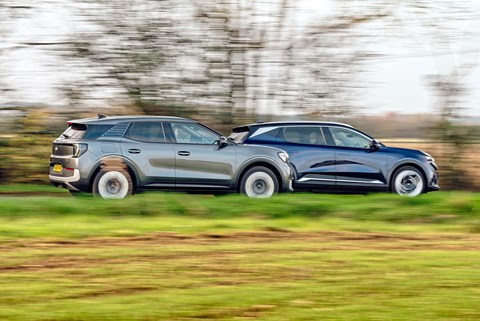
Although the Explorer shares its wheelbase with the ID. 4, it’s shorter overall because of its truncated tail. The Scenic sits somewhere in the middle in terms of capacity, if not convenience. For a start the boot opening is much higher, creating a big loading lip to hump your bags and boxes over. You then notice the load area isn’t anywhere near as long as those in the other cars here. Instead, the capacity comes from height, with a deep well in the floor.
As well as minimal loading lips, the Ford and Tesla have rather laughable parcel shelves. The Explorer’s is a flimsy bit of fabric that at least rises with the bootlid. The Tesla’s needs manually moving.
Both the Model Y and Scenic come with useful 40/20/40 folding rear seats, while the Scenic goes a step further in offering a two-level boot floor. The Explorer makes do with a more common 60/40 split, albeit with a useful load-through hatch.
For rear passenger space, the Scenic wins by some margin, offering legroom that feels like it’s from the class above. Headroom is also good, helped by the panoramic roof that’s able to turn opaque, negating the need for a space-sapping roof blind. A flat floor helps when you have three in the back, although a bit more room under the front seats would be welcomed by rear passengers with big shoes.
Special mention should also go to the Scenic’s cunning rear armrest. Not only does it hide two C-USB ports (as well as the two between the front seats) there are also two cupholders, a shallow lidded cubby and clever rotating smartphone cradles. These allow a couple of passengers to watch their different favourite shows in peace, or you can swing them around to create a cradle for an iPad or other tablet. Anything that can stop siblings squabbling or prevent back-seat boredom is worthy of celebration in my book.
It’s the Model Y that feels next most spacious, exaggerated by the light coming in from the big windows and this car’s vast panoramic roof. A 6ft 2in adult, sitting behind similarly tall front-seat occupants, has enough space in the Ford and Tesla, just not quite as much as in the Scenic.
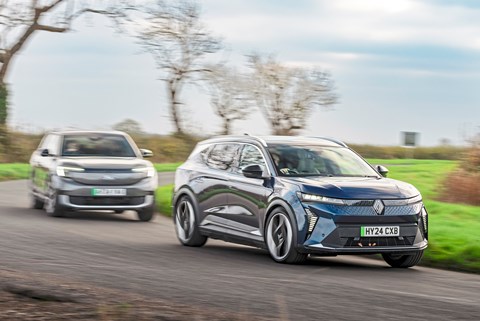
Up front, all three provide lots of headroom, and in every case the driver’s seat goes back far enough for long legs, and close enough to the pedals for those best described as fun-sized.
Interior quality hasn’t been a Ford strong point of late, with both the recently facelifted Kuga and Puma feeling well off the pace. The Explorer is certainly better than them, but is outshone by the Scenic and Model Y. I like the Ford’s soft-touch, light-coloured plastics, and what little switchgear there is feels decent. It’s a shame that the movable infotainment screen doesn’t feel built to last and looks a bit basic.
The Tesla has quite a variety of squishy plastics and metal-effect trims, while its digital display is undoubtedly the crispest and most responsive, if not the easiest to navigate for me. It also offered an array of squeaks and rattles, and aspects of the layout just don’t work for me. Having no display in front of you to show your speed is at best annoying, and there’s just too much going on in the infotainment system, including the heating and mirror adjustments.
The Explorer isn’t quite so button-light as the Model Y, but it’s not far off. The Scenic’s interior is not perfect – a lot of hard plastic – but it’s so much more user-friendly than the others. Little touches like the fabric-wrapped dash and pixel-effect wood trim provide a modern yet welcoming ambience, and plush materials are used in the areas you touch regularly. It also has actual buttons to control the ⊲ heating and various other functions, including one to turn off any unwanted driver assists with just a couple of button pushes.
Some of my younger colleagues have dared suggest Renault might have taken this emphasis on physical controls a bit too far. There are four stalks jutting out of the steering column: conventional light and wiper controls, another for selecting drive and reverse, and a fourth for the audio controls – a decades-old French tradition.
It sounds like a mess when you describe it, and I guarantee you’ll accidentally turn the wipers on when you’re looking for reverse several times, but you quickly get used to them. It’s the same story with the heater controls – adjusting the temperature or fan speed without looking is easy.
On balance, the Scenic has the best infotainment system here, too. It’s not information overload like the Tesla and looks less like PowerPoint than the Ford’s. Instead, it’s responsive, looks good and, unlike the Tesla, has both Android Auto and Apple CarPlay baked in.
Our efficiency testing was carried out on our usual loop, taking in a bit of suburban Peterborough, some 60mph-limit B-roads punctuated by 30mph zones, and a stint on the A1(M). It’s a tougher ordeal than you’ll get from WLTP, and led to some interesting results.
In last place for efficiency is the Renault Scenic, managing a mere 3.3 miles per kWh. With its 87kWh battery, that’s enough for a real-world range of 287 miles, nearly 90 short of the official figures. Our experience thus far with the Scenic suggests it’s much happier away from the motorway, and will top 300 miles fairly easily.
Slightly better is the Explorer at 3.6 miles per kWh, against an official figure of 4.2. The 77kWh battery gives a range of 325 miles.
On the same route, on the same day, driving in convoy with my colleagues while occasionally swapping drivers and even positions on the road for fairness, the Model Y didn’t just match its official figure of 4.0 miles per kWh, it bettered it at 4.1. That’s enough to take the range from an official 373 miles up to a hefty 381.
Not only can you go farther with a Tesla, you can charge it faster too on a visit to the excellent Supercharger network; it’ll charge at up to 250kW. Tesla claims you can add up to 150 miles of range in just 15 minutes, or get from 10 to 80 per cent full in around 25 minutes, assuming the battery is at the right charge level and temperature. You’re looking at over 12 hours to get from empty to full using a typical 7.4kW home wallbox.
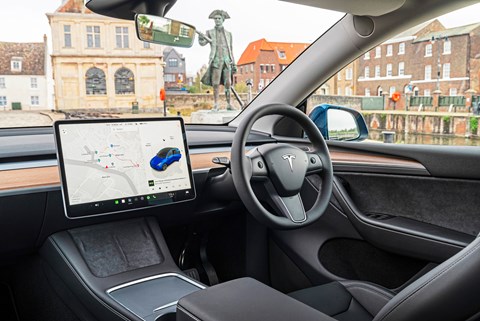
The Explorer can’t charge anywhere near as quickly, and you’re at the mercy of the wider public charging network. Its maximum charging rate is a relatively low 135kW, but the modest size of the battery means it’ll take less than 30 minutes to get from 10 to 80 per cent charged on a punchy enough rapid charger. If you’re using a 7.4kW home wallbox, you’re again looking at over 12 hours of charging.
The Scenic has a 150kW maximum rapid charging rate but a relatively big battery. That means it takes a yawning 37 minutes to get from 15 to 80 per cent full. Stick it on your 7.4kW wallbox and that time increases to very nearly 13 hours. Alternatively, you can benefit from 11kW charging; both the Tesla and Renault can take up to 22kW on a three-phase Type 2 plug.
Price will be a big factor for most family-focused buyers. The Explorer can be had for about £40,000, and that entry model has an even better range than this version, but a top-spec RWD is basically £50k to buy outright. That’s a good £3k more than the Model Y, with the Scenic undercutting both.
A top-spec Scenic Iconic is less than £46k, and a Long Range version in entry-level but still well-equipped Techno trim is a fiver shy of £41k. That’s a significant gap compared to today’s two rivals, and it opens even wider if you delve into the murky world of finance. For example, a 48-month PCP with a £5000 customer deposit and a relatively high annual mileage limit of 12,000 gives you access, at the time of writing, to manufacturer-backed zero per cent APR schemes, although you’ll need a five-figure deposit to get that from Renault. It’s the Explorer that’s priciest on PCP at £522 a month followed by the Model Y at £508 a month, while the Scenic is the only one to dip below £500 a month.
Ford Explorer vs Tesla Model Y vs Renault Scenic: the final reckoning
There’s a clear winner in this test, but third place is a much trickier call. In some ways it should be the Ford Explorer that finishes last. After all, it has the smallest boot and the least appealing interior, it could be more comfortable, and is the priciest by some margin. But then again it steers and rides like a true Ford should, despite the Volkswagen chassis fundamentals it’s built on, and despite the weight. It’s been so well set up, in accordance with Ford tradition, that it’s always a pleasure to drive the Explorer.
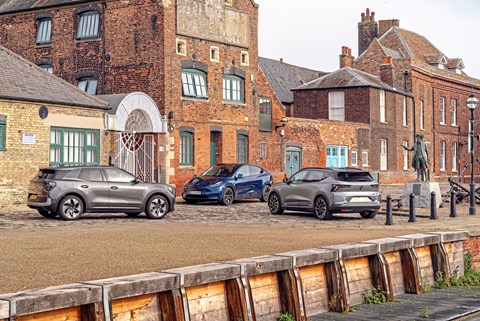
The Tesla Model Y is far less user-friendly than the Ford, unless you’re fully at ease with a cabin that puts almost all controls in the central touchscreen; some people take to it readily, while some take a while to get used to it, and others never get that far.
That’s a big part of the reason the Model Y takes an unfamiliar third place. The other is that it just isn’t good enough to drive, especially at low speeds. Sure, the throttle and brake response are top notch, but the steering and ride both feel unfinished. People often think of the Model Y as a taller Model 3, but the 3’s generally fine handling has got lost in the transition.
Let’s hope Tesla’s next set of revisions sort this out, as the Model Y does so much right. Its efficiency is class-leading, as is the Supercharger network, but I would be annoyed with myself as a car enthusiast if I ended up with one on my driveway. That simply wouldn’t be the case with the Explorer.
So, if the Explorer’s polished driving dynamics are enough to give it second place, our winner has to be the Renault Scenic. Again. Our tested efficiency and calculated range are on the disappointing side, and there are quicker and sharper-handling alternatives. However, a range of around 300 miles is still good, and it has ride comfort on its side. Performance is more than sufficient, and it’s so spacious for rear passengers.
There’s also an awful lot to be said for having switches and stalks to control key functions rather than jamming everything inside of a touchscreen. Similarly, an easy-to-reach button that kills the electronic nagging is a most welcome thing on a brand new car.
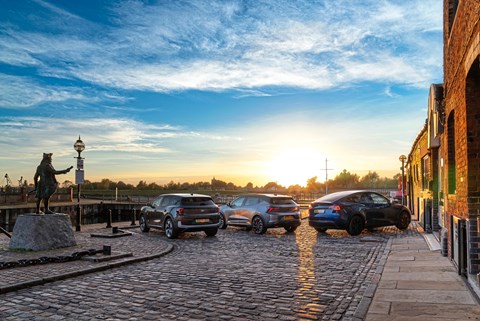
And then there’s the price. If the Renault was similar money to the Explorer and Model Y, we might be looking at a different winner. Because it undercuts them both, with some stonking finance deals, it becomes an easy win for the Renault. At least until that next Model Y upgrade comes out…
Ford Explorer vs Tesla Model Y vs Renault Scenic: the verdict
First place
Renault Scenic
Comfortable, practical, user-friendly and charismatic family transport
★★★★
Second place
Ford Explorer
Ford makes a better VW, but let down by a small boot
★★★★
Third place
Tesla Model Y
Good in so many ways, but the ride and steering are poor and the interface infuriating
★★★